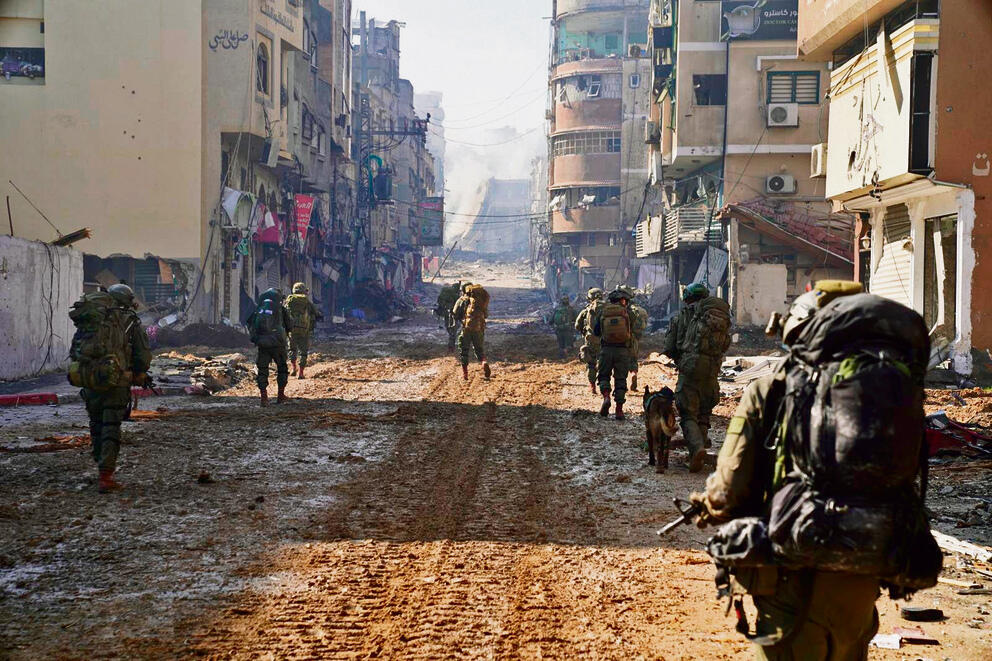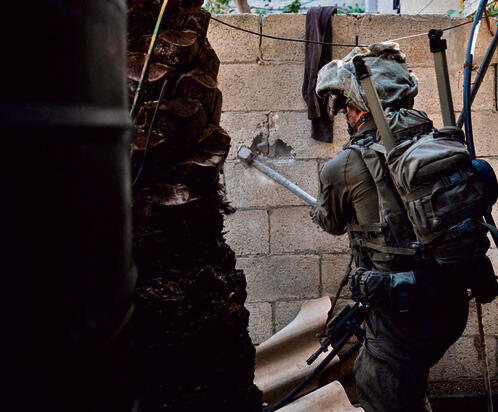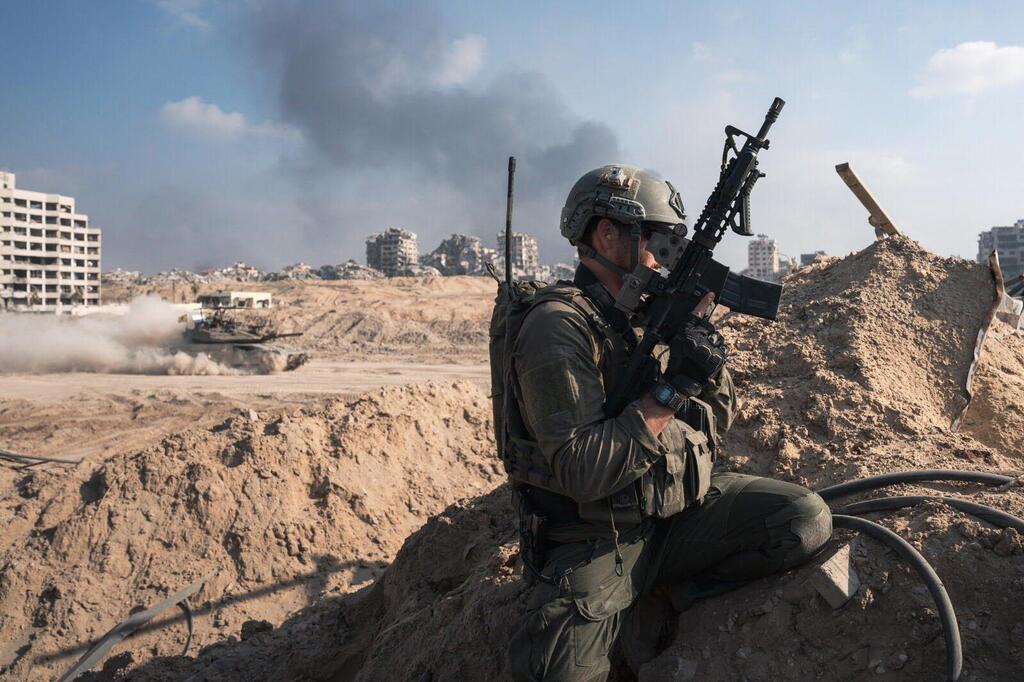After driving for more than ten minutes from the western border into the depths of the Strip toward Khan Younis, the only sight that meets the eyes is one of utter devastation. It's a destruction of huge, almost biblical proportions. No home in the area is habitable, and not a single person remains, let alone pets. A few stray cats and dogs roam, appearing to contemplate their steps in bewilderment and confusion.
Read more:
This is the catastrophe of 2024, a disaster for the Palestinians in every sense. It's a calamity that the Gazans and Hamas have brought upon themselves. It's uncertain whether they even comprehend the enormity and extent of the devastation. The daily videos that Hamas releases, which supposedly document strikes on Israeli forces, cannot begin to make up for this disaster, for the extensive damage that will take many long years to repair.
We are now 2.5 miles into the strip, just under two miles from the sea, and yet there are no houses in sight that have been left untouched by significant damage. One can only speculate about the length of time it will take to remove the debris from these houses on "the day after". On that day, hundreds of thousands of Palestinians will wish to return to their homes, only to find nothing but ruins upon ruins.
Still, no gunfire is heard here. Hamas has retreated, is in hiding, and avoids direct confrontation with IDF soldiers, choosing instead to seek refuge in tunnels. They have abandoned Khan Younis, an emblem of the organization and the military wing's starting point, allowing it to collapse completely, both above and beneath the ground. Even if Hamas survives this event and manages to release thousands of Palestinian prisoners, it will still not be able to offer any logical justification for the reckless gamble of October 7, a cost that every resident of the strip is now bearing.
Facing the commanding officer yet again
Reservists from the 646th Brigade are the force at work in this area that leads to the core of Khan Younis and to the center of IDF operations encircling the city's refugee camp. They've shared with us that in the near future, within these conflict areas, gunfire will become a frequent occurrence. Their presence in Gaza has been extended over many days, accumulating to over 120 days of continuous reserve duty. It may seem extreme, yet this represents the emerging reality that Israel must confront this year, and potentially in the years ahead. Combat troops are facing the prospect of increasing reserve duty days annually. The troops hail from diverse backgrounds across the country—secular and religious, from kibbutzim to urban areas. Despite high morale, there's a palpable sense of exhaustion and a longing to finally return home.
The sound of these blasts resonates distinctly in Khan Younis, and there's a high probability that the reverberations reach even into the tunnels that shelter Hamas leaders. The impact on the military wing from the ongoing conflict is significant. In any conventional confrontation between two militaries, the victor could have been identified early on—despite the grave outcomes from the day the conflict erupted.
"The IDF is functioning like an immense shredder," an officer described, "progressing incrementally every day." The brigade's officers have also elaborated on the extent of the damage inflicted on Hamas: "The Khan Younis Brigade comprises four battalions, and effectively, three of these have been neutralized. What does neutralization entail? It's not that these battalions lack active members; fighting persists, and daily, many are killed. However, if their leaders are incapacitated or have deserted, if 60-70% of the combatants have been eliminated, and a similar proportion of their weaponry has been damaged or seized by us, then they are regarded as neutralized.
"We can assert with certainty that this is the case for three of the four battalions. The battalion commander of Khan Younis has absconded and abstained from combat. Yet, the conflict is far from concluded. In our sector alone, approximately 200 members are still concealed within the tunnels. They navigate in civilian attire, unarmed, stashing their weapons in various hideouts, emerging to launch attacks before vanishing once more. In recent weeks, we haven't come across any group larger than four individuals. The elite Hamas units, such as the Nukhba, are no longer engaging us in battle. Their main efforts are now focused on disrupting logistical routes."
The enduring challenge is the aftermath scenario. Brigade 646 is currently active in a region previously addressed by another reserve unit. Their mission now involves revisiting and systematically clearing areas with a more profound approach to eradication. An officer articulates the predicament, "In any place we fail to engage, in any location we vacate, Hamas will inevitably attempt to make a comeback and attempt restoration," he says, "and it's a fallacy to believe our departure will alter existing dynamics."
Drawing a parallel, the officer references the Taliban's resurgence in Afghanistan, which occurred despite two decades of American military intervention, culminating in the Taliban's swift return to power following the withdrawal of U.S. forces. He suggests a similar entwinement exists here, where Hamas is deeply interwoven with the societal fabric. Should any other force attempt to fill the void left by Hamas, it is expected to face relentless opposition from its operatives.
Making history
Despite the substantial military operations and the significant destruction incurred, there is a possibility that the local population may increasingly seek a substitute for Hamas. Should the IDF persist in its prolonged offensive, it is conceivable that the group would find it challenging to counter a different ruling power. Moreover, the intensified military activity is putting additional stress on the topic of prisoners. The indication that Hamas has ceased to demand a complete Israeli pullout from Gaza before starting negotiations suggests that the IDF's advancements in Khan Younis and elsewhere are making an impact, potentially paving the way for a future agreement. While such an outcome might still appear remote, it is no longer outside the realm of possibility.
As we progress to our next location, where IDF artillery is more intense, we encounter little to no resistance from Hamas fighters. Homes affiliated with Hamas members are marked and dealt with severely. These houses are either bombed or, in some cases, deliberately set ablaze with everything inside. This might be due to the higher risks and costs associated with bombing or staging ambushes.
The reserve soldiers are methodically clearing each sector, inspecting houses, obliterating tunnels, and targeting operatives' homes. There's a universal yearning among them to return to their homes, yet there's also a candid conversation about how to reintegrate into civilian life. "How can one seamlessly transition back to normal life after being part of such a significant historical conflict?"






